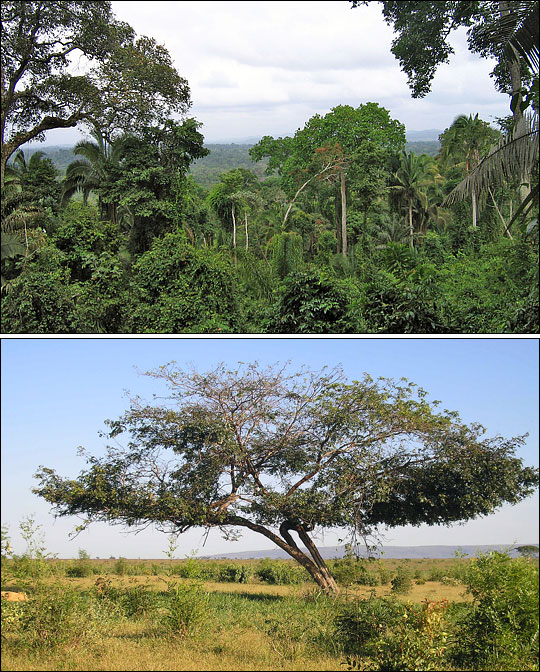

Forecasting the Future of the Amazon |
|||
As counterintuitive as a “good” dry season might seem, that response is perfectly in tune with research about the soil-water-tapping potential of mature rainforest trees. Since the early 1990s, field studies and soil-moisture modeling research have been accumulating evidence that in the undisturbed rainforest, roots extend as far as 20 meters (more than 60 feet) into the soil, where the wet-season rains are stored. Rather than being a time of stress, the normal dry season may be the forests’ most productive time of year because the rain clouds clear up, and more sunlight reaches the forest. |
|||
 |

But the dry-season green-up only happens in undisturbed forests, stresses Huete. At locations where the forest has been converted to pasture or farmland, the dry season has the more intuitive effect: the vegetation “browns down” in response to decreased soil moisture. Once the deep roots of the mature trees are lost, the access to the water stored deep in the soil is lost as well. |
Pastures cleared from rainforests show the opposite seasonal pattern from undisturbed rainforest. These graphs show the relationship between vegetation greenness (top), rainfall (middle), and sunlight (bottom). Greenness in forest areas (green line) increases when rainfall is low and sunlight is high (July-December). Greenness in pastures (gold line) increases in the rainy season (January-June). (Graphs by Robert Simmon, adapted from Huete 2006.) | |

| |||
“Some current ecological models of the Amazon actually have the Amazon getting browner during the dry season,” explains Huete. If the seasonal cycle of green-up and photosynthesis in a model is wrong, the ability to predict uptake and release of carbon dioxide, water availability, and fire risk would probably be off as well. Among the key implications, explains Saleska, is the fate of the Amazon itself. In most models that link simulations of global climate to vegetation dynamics, the Amazon has a big influence on carbon because even small changes in the great stores of carbon in the vast Amazon forests can have significant impacts at the global scale. “But what we are learning is that Amazon is highly sensitive to hydrological change,” he says. “When the modelers couple their climate models to ecosystem models of the Amazon and run them out over the next century, some models predict that Earth’s warming climate will cause the whole Amazon ecosystem to collapse, to become a savanna.” Instead of a dense forest richly layered with trees, shrubs, plants, and vines, the whole area could instead be covered by grass and scattered trees. In addition to the radical transformation of the ecosystem and loss of biodiversity, “there would be significant global impacts of that collapse,” explains Saleska. After taking into account the current rates of deforestation, scientists think the Amazon region may be neutral with respect to carbon losses and gains. But if savanna replaced the rainforest, says Saleska, “the whole area would switch from being close to neutral on average to being a big source of carbon.” “But if these models are getting the seasonality wrong, then the impacts [of climate change] may not be what we expect,” he continues. Predictions of ecosystem collapse are based on the idea that the dry season is a time of stress and declining greenness. If that isn’t true, then perhaps the Amazon will be more resilient than the models predict. On the other hand, a typical dry season isn’t the same as a lengthy El Niño-induced drought. Previous studies, including a drought-simulation experiment conducted during LBA, indicate that the more severe, extended declines in rainfall that can happen during strong El Niño events do produce stress in the forest, especially fragmented or damaged areas. With forest disturbance on the rise and predictions by some climate models that El Niño events may increase as climate warms, the fate of the Amazon is unclear. In the near future, Saleska and Huete will be working together to do a synthesis of all the available LBA tower observations with the satellite data to come up with a basin-wide estimate for the flux of carbon in the Amazon. In the meantime, says Saleska, everyone is keeping their eyes out for the next strong El Nino because observations collected during the event could provide the next key piece of the puzzle of how the Amazon responds to large-scale climate variation and change. Knowing the Amazon’s baseline seasonal response should help scientists judge when and how future climate events may disturb the balance of such an important and sensitive ecosystem.
|
Because of the Amazon’s size and productivity, small changes in the carbon stored there can produce a global effect. Many ecological models are based on the idea that the dry season is a time of stress. Some models predict that future warming and drying of Earth’s climate may cause the rainforest ecosystem to collapse, turning the area from lush forest (top) into tropical savanna (below). Such a transformation would dramatically change the Amazon’s role in the global carbon cycle. The discovery of a dry-season green-up indicates that many questions remain about how the Amazon will respond to climate change. (Rainforest photograph copyright Brant Olson, pasture photograph copyright Lady Drid.) | ||